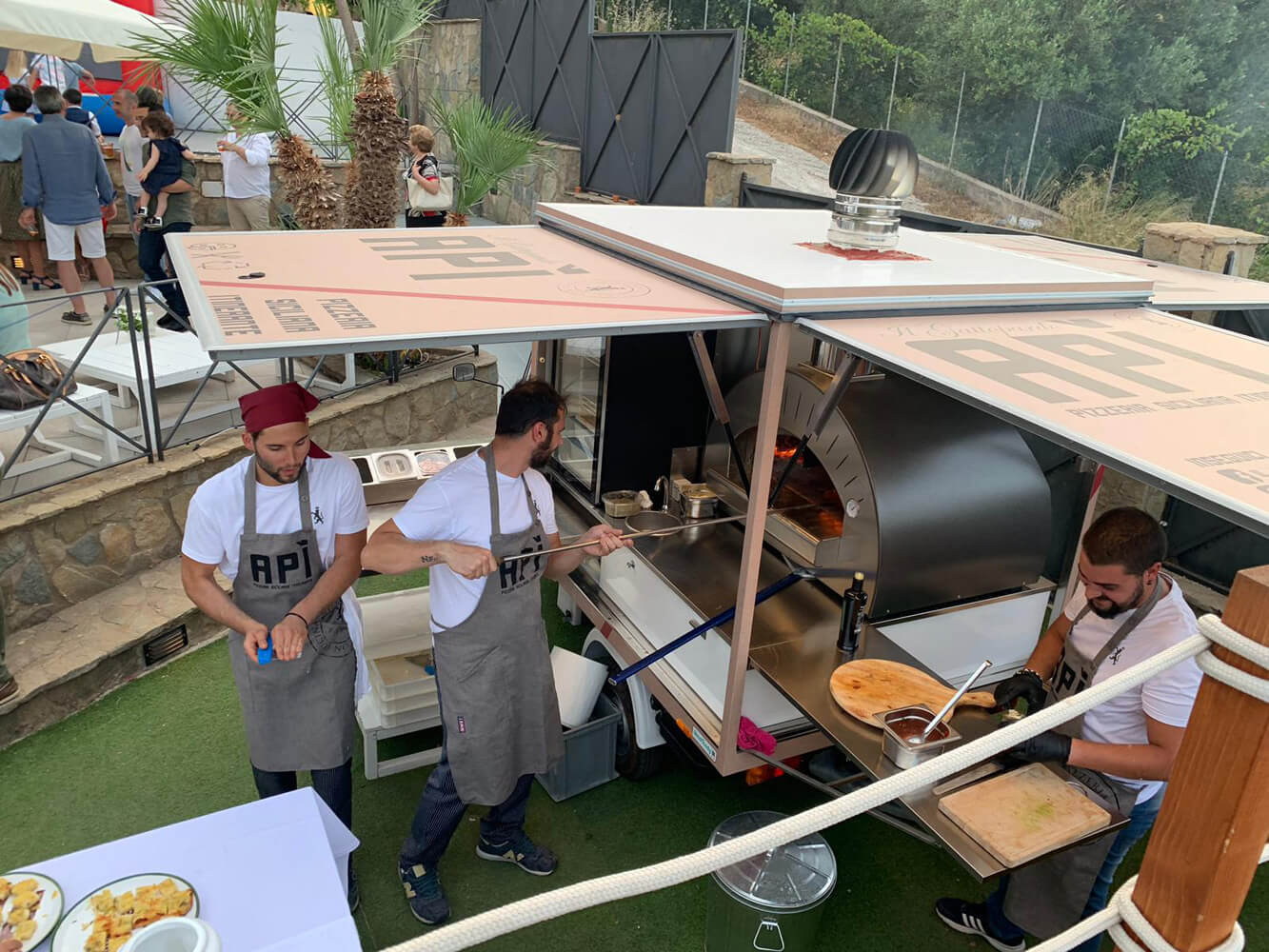The spread of food trucks as an itinerant solution for the hospitality industry has been steadily increasing for some years, especially in big cities where many people are concentrated in a small space and take their lunch on the fly near their workplace.
Pizza is a staple of the so-called street food because, basically, everyone loves it and then for the possibility of preparing it in a tiny but properly outfitted place. Being able to serve a perfectly cooked pizza during a short lunch break is an extremely satisfying experience and even more so if consumers can observe the chef at work while preparing their pies.
In this article, we will give you some useful tips to set up a food truck to make pizza, to organise your work in the best way and to choose the right equipment to do it, notably the commercial oven. We will focus on “restaurant on wheels” business and on the main features that a commercial pizza oven for street food must have, highlighting the qualities of Alfa steel ovens and expounding on the reasons why they are the most suitable commercial ovens for this market sector.
How to start a “pizzeria on wheels”
Street food is a type of catering activity with smaller dimensions and lower overheads than a traditional restaurant. In the case of food trucks, their mobility allows them to get nearer to potential customers during events such as fairs and festivals.
Here we will see the three key aspects to set up a pizza street food business:
- The brand creation
- The work organisation
- The choice of vehicle and equipment
Let’s look at them more closely.

1. The brand creation
The food truck proposal works when there is a well-defined business identity that may be due to a specialisation in a particular cuisine that customers can immediately recognise.
The distinguishing feature may refer to the type of dish (pizza, fry-ups, burgers…), specialty cuisines (vegan, gluten-free…) or locally sourced food (focaccia genovese or barese, Neapolitan pizza or arrosticini abruzzesi…).
Pizza is undoubtedly one of the most popular dishes in the world and if it is the signature course of your menu, it will be crucial to deal with complementary aspects such as preparing the vehicle, organising events for attracting clients or trying new ways for promoting your venture.
To beat the competition, building a brand identity and presenting the product to your customers in the most effective way are key to success. Word-of-mouth marketing to get people talking of your food business is one of the best practices in the hospitality industry.
The brand is clearly a tool that catches customers’ attention in strategic environments like streets or festivals and may be a gateway to an all-encompassing consumer’s experience that can turn into a powerful competitive advantage.
Don’t hesitate to read the article in our blog on how to attract customers to your restaurant and stand out from the competition.
2. The work organisation
The amount of work required in a street food business, both in terms of pizzas to be made or the number of hours to put in, depends basically on the type of location and the ability to attract customers to your place. Choosing the food to serve and the implements to do it will affect your organisation.
In short, we can divide the work into three phases:
- Before moving to the final location
- Upon arrival at the chosen place
- During the service
Before moving to the final location
- You must take care of the “mise en place” that is the preparation of the equipment and the ingredients (chopping veggies, making sauces and condiments…)
- Then make pizza dough (paying attention to the right quantity of yeast according to the fermentation time and the temperature inside and outside the fridge)
- And finally gear the truck and load the fuel for the oven (firewood or gas bottles)
Upon arrival at the chosen place
The first thing to do when you reach your location is to park the food truck in the area designed by the event organisers or the municipality.
- Now it’s time to buckle down to making pizzas, so turn on the oven, organize the worktop, stretch the dough and put the toppings
- Try to make your truck more attractive to clients acting on elements like colour, logo and text
During the service
This is the phase where you work as you’d do in a restaurant except for the physical limitations due to a smaller space.
Before you call it a day, turn off the oven, clean everything up and go back home without forgetting to put away the tools and the unused ingredients.
3. The choice of the vehicle and equipment
When it comes to start a mobile pizza business, the choice of the vehicle must take into account the kind of cuisine that you want to serve and the type of equipment you will need to do it. You might want to use a wood-burning oven to bake your pizzas, but this would require extra space to store the firewood.
The vehicle represents the company’s style and is absolutely essential for the success of the business.
You can buy a fully equipped van or customize your own food truck. In the first case the price will be higher, in the second one the initial cost will be lower, but it could increase considerably allowing for the necessary outlays to personalize the vehicle to fit your business’ needs.
They come in many sizes: truck, trailer, Piaggio Ape, van, you name it. It’s advisable that the vehicle undergo a complete engine overhaul before outfitting it with the tools needed for your business making sure to use the space efficiently. The next step is to improve the visual appeal of the truck to make people remember it and then to install the proper appliances and fixtures.
The next step is to improve the visual appeal of the truck to make people remember it and then to install the proper appliances and fixtures.
The minimum equipment required to make pizza consists of a commercial oven, a refrigerator, a worktop and a sink.
If you still have space left, you could add a drink fridge or a deep fryer bearing in mind that these appliances must be as light and energy-efficient as possible.

How to choose the right oven for making street food pizza?
In a “pizzeria on wheels” you can’t absolutely do without a wood-fired or a gas-fired oven.
Firewood has a higher cost and takes up more space but bakes pizza like no other.
Gas is more practical, cheaper and easier to handle even though cooking with gas is not as special as cooking with wood.
Anyway, whether it is burning wood or gas, a food truck oven must have:
- High productive capacity
- High cooking speed
- Lightness and ease of movement
Let us see them in detail.
High productive capacity
Evaluating the oven’s output capacity means comparing the number of pizzas baked per hour or per evening with the total fuel consumption and the time needed to reach the best temperature.
A high-calibre oven quickly hits the right temperature, maintains it for a long time, bakes food to a t and consumes little fuel.
High cooking speed
Simply put, a fast oven is an appliance that cooks many pizzas in a short time and that comes in handy when you are dealing with the lunch rush. In this case, an oven that maintains a high temperature for a long time allows you to obtain excellent results with low energy consumption.
Usually, a large oven holds a constant temperature for longer, but food truck businesses are normally manned by one person and it would be difficult to manage the cooking of 5/6 pizzas at the same time, admitting that you have enough space to install it.
Lightness and ease of movement
A light oven can be moved more easily and is better suited to the physical limitations mostly imposed by food trucks and the need to maximise space.

The ALFA steel oven is a perfect match for the food truck
Now let us see why Alfa ovens are the definitive choice for this kind of business. Alfa is a signature brand in the industry of commercial pizza ovens thanks to its commitment to research and innovation.
A vivid example of this dedication is certainly the Forninox patent that allows to manufacture refractory ovens with stainless-steel lining. By applying this technology, we have managed to develop super light ovens that reduce heating time and cut down energy consumption
In this article in our blog, you can have a look at how to install Alfa ovens in different types of food trucks to draw some inspiration to outfit your vehicle.
But why select Alfa pizza ovens for your “pizzeria on wheels”?
The answer is that Alfa ovens are:
1 – Ovens that guarantee a perfect and fast cooking
Alfa steel ovens hit 450 °C in a few minutes compared to 2/3 hours for traditional ones.
The steel dome accumulates heat very quickly and keeps it for a long time allowing you to lengthen cooking sessions.
2 – Very light ovens
Steel ovens are much lighter than brick ones and are therefore easier to move to meet all your baking needs.
To increase this advantage, we added a wheeled base that sets up in a jiffy.
3 – Ovens with a captivating design
Another strong point of Alfa’s ovens is their elegant design that conveys the idea of harmony between tradition and innovation and may positively influence the perception that customers have of your culinary offer.

Alfa and street food: a winning pairing
At the end of the day, Alfa ovens are simply perfect for starting your street food business.
They reduce the overall fuel consumption, make the vehicle lighter, help build a strong business image and, most of all, deliver excellent cooking results.
Our product range includes medium-to-large models that fit vehicles such as vans or trucks or smaller ones that are aimed at three-wheelers such as the Piaggio Ape.
In the first case, we suggest the Quick oven which can bake more than 100 pizzas per hour (up to 6 at the same time) while maintaining very high temperatures.
For smaller models, we recommend the Quattro Pro, with or without base, which weighs less than 200 kg, hits a temperature of 450 °C in just half an hour and can cook up to 60 pizzas per hour (3 at once).
All Alfa commercial steel ovens run on firewood or gas and some hybrid versions are available too.
Making pizza on a food truck may be very challenging but it can also be a terrific opportunity to start a restaurant activity with relatively low operating costs so when it comes to the oven, making the wrong choice is not an option!




